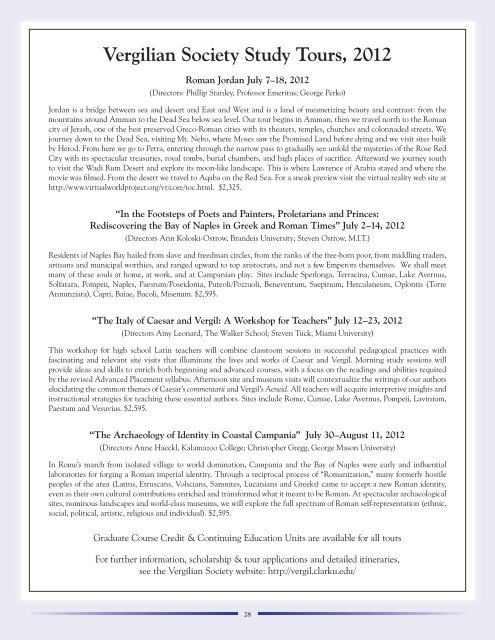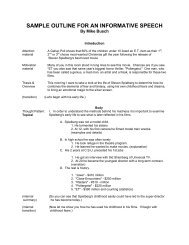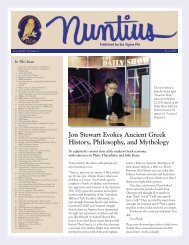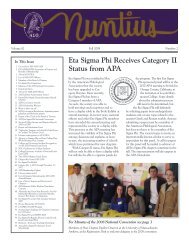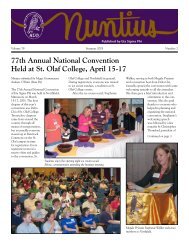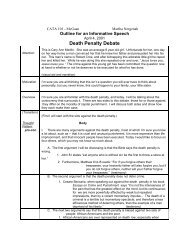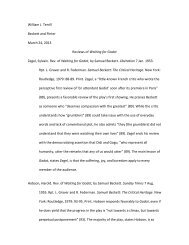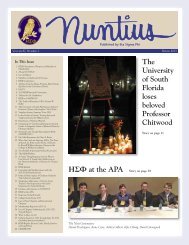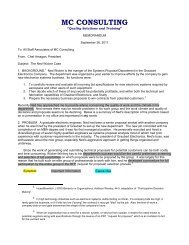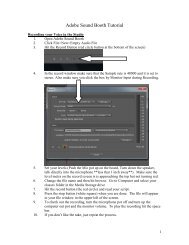In the Land of the Sibyl - Monmouth College
In the Land of the Sibyl - Monmouth College
In the Land of the Sibyl - Monmouth College
Create successful ePaper yourself
Turn your PDF publications into a flip-book with our unique Google optimized e-Paper software.
Vergilian Society Study Tours, 2012<br />
Roman Jordan July 7–18, 2012<br />
(Directors: Phillip Stanley, Pr<strong>of</strong>essor Emeritus; George Perko)<br />
Jordan is a bridge between sea and desert and East and West and is a land <strong>of</strong> mesmerizing beauty and contrast: from <strong>the</strong><br />
mountains around Amman to <strong>the</strong> Dead Sea below sea level. Our tour begins in Amman, <strong>the</strong>n we travel north to <strong>the</strong> Roman<br />
city <strong>of</strong> Jerash, one <strong>of</strong> <strong>the</strong> best preserved Greco-Roman cities with its <strong>the</strong>aters, temples, churches and colonnaded streets. We<br />
journey down to <strong>the</strong> Dead Sea, visiting Mt. Nebo, where Moses saw <strong>the</strong> Promised <strong>Land</strong> before dying and we visit sites built<br />
by Herod. From here we go to Petra, entering through <strong>the</strong> narrow pass to gradually see unfold <strong>the</strong> mysteries <strong>of</strong> <strong>the</strong> Rose Red<br />
City with its spectacular treasuries, royal tombs, burial chambers, and high places <strong>of</strong> sacrifice. Afterward we journey south<br />
to visit <strong>the</strong> Wadi Rum Desert and explore its moon-like landscape. This is where Lawrence <strong>of</strong> Arabia stayed and where <strong>the</strong><br />
movie was filmed. From <strong>the</strong> desert we travel to Aqaba on <strong>the</strong> Red Sea. For a sneak preview visit <strong>the</strong> virtual reality web site at<br />
http://www.virtualworldproject.org/vr/core/toc.html. $2,325.<br />
“<strong>In</strong> <strong>the</strong> Footsteps <strong>of</strong> Poets and Painters, Proletarians and Princes:<br />
Rediscovering <strong>the</strong> Bay <strong>of</strong> Naples in Greek and Roman Times” July 2–14, 2012<br />
(Directors Ann Koloski-Ostrow, Brandeis University; Steven Ostrow, M.I.T.)<br />
Residents <strong>of</strong> Naples Bay hailed from slave and freedman circles, from <strong>the</strong> ranks <strong>of</strong> <strong>the</strong> free-born poor, from middling traders,<br />
artisans and municipal worthies, and ranged upward to top aristocrats, and not a few Emperors <strong>the</strong>mselves. We shall meet<br />
many <strong>of</strong> <strong>the</strong>se souls at home, at work, and at Campanian play. Sites include Sperlonga, Terracina, Cumae, Lake Avernus,<br />
Solfatara, Pompeii, Naples, Paestum/Poseidonia, Puteoli/Pozzuoli, Beneventum, Saepinum, Herculaneum, Oplontis (Torre<br />
Annunziata), Capri, Baiae, Bacoli, Misenum. $2,595.<br />
“The Italy <strong>of</strong> Caesar and Vergil: A Workshop for Teachers” July 12–23, 2012<br />
(Directors Amy Leonard, The Walker School; Steven Tuck, Miami University)<br />
This workshop for high school Latin teachers will combine classroom sessions in successful pedagogical practices with<br />
fascinating and relevant site visits that illuminate <strong>the</strong> lives and works <strong>of</strong> Caesar and Vergil. Morning study sessions will<br />
provide ideas and skills to enrich both beginning and advanced courses, with a focus on <strong>the</strong> readings and abilities required<br />
by <strong>the</strong> revised Advanced Placement syllabus. Afternoon site and museum visits will contextualize <strong>the</strong> writings <strong>of</strong> our authors<br />
elucidating <strong>the</strong> common <strong>the</strong>mes <strong>of</strong> Caesar’s commentarii and Vergil’s Aeneid. All teachers will acquire interpretive insights and<br />
instructional strategies for teaching <strong>the</strong>se essential authors. Sites include Rome, Cumae, Lake Avernus, Pompeii, Lavinium,<br />
Paestum and Vesuvius. $2,595.<br />
“The Archaeology <strong>of</strong> Identity in Coastal Campania” July 30–August 11, 2012<br />
(Directors Anne Haeckl, Kalamazoo <strong>College</strong>; Christopher Gregg, George Mason University)<br />
<strong>In</strong> Rome’s march from isolated village to world domination, Campania and <strong>the</strong> Bay <strong>of</strong> Naples were early and influential<br />
laboratories for forging a Roman imperial identity. Through a reciprocal process <strong>of</strong> “Romanization,” many formerly hostile<br />
peoples <strong>of</strong> <strong>the</strong> area (Latins, Etruscans, Volscians, Samnites, Lucanians and Greeks) came to accept a new Roman identity,<br />
even as <strong>the</strong>ir own cultural contributions enriched and transformed what it meant to be Roman. At spectacular archaeological<br />
sites, numinous landscapes and world-class museums, we will explore <strong>the</strong> full spectrum <strong>of</strong> Roman self-representation (ethnic,<br />
social, political, artistic, religious and individual). $2,595.<br />
Graduate Course Credit & Continuing Education Units are available for all tours<br />
For fur<strong>the</strong>r information, scholarship & tour applications and detailed itineraries,<br />
see <strong>the</strong> Vergilian Society website: http://vergil.clarku.edu/<br />
28


